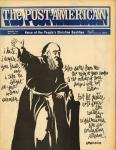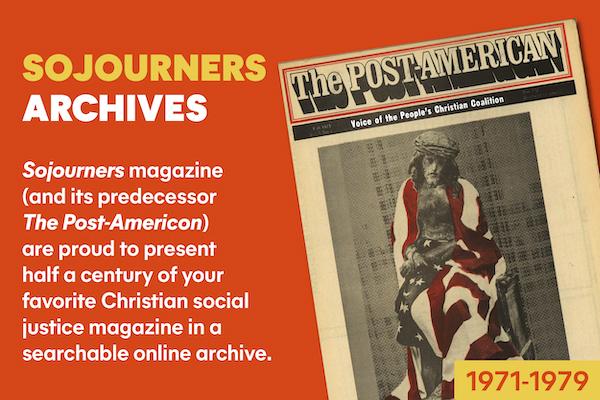Children, artists, and prophets have one thing in common. They see things with fresh eyes.
When my daughter was two, we were in the Art Institute in
“What do you see?” the Lord asked Jeremiah. Prophets, too, see things others do not. The Bible tells how Jeremiah once went down to the local department store, bought a brand new kilt in the latest fashion and put it on. But then he took it off again and buried it on the bank of the
Artists, painters, poets, writers see new visions, images. “Every work of art, every real creation is a revolt … a revolt in the name of fresh perception … a revolt which invents new languages, unsuspected forms, surprising juxtapositions,” according to Michael Kustow, director of London's Institute of Contemporary Arts (New York Times, Sunday, August 2, 1970). It is not the business of the artist to change the world, Kustow points out, but the artist does change the way we see, the way we feel, the way we hear.
The life of art lies in "the transformation of forms," the restless, ceaseless, creative dissatisfaction of the artist with things as they are. The artist teases us, entices us, jars us into seeing in new ways. He shocks us into seeing—the invisible! Ralph Ellison, against our will, points out to us our invisible neighbor, in The Invisible
"Surprising juxtapositions"—One of the most powerful dramatic creations I have experienced is a multimedia performance, "The Civil War," staged in
What the artist does is challenge us to let our “out-look” change, to play with the pair of glasses through which we see the world. Here, try this pair, now try that one. How does it look from this angle? What if you step over here and look? “The important thing is to pull yourself up by your own hair, to turn yourself inside out and see the whole world with fresh eyes,” says Marat in Marat/Sade.
What does this have to do with political consciousness? I suggest that it is a matter of life and death whether we learn to apply this artistic restlessness, dissatisfaction, to the way we see political reality. Politics is the sphere of power. It is urgent that we take very seriously the “power of the imagination,” that we expand our image of “politics” to understand this kind of power. According to Michael Novak, “politics is, in a sense, a world of illusions; of shifting symbols …” (Politics: Realism and Imagination, p.11). It is imperative that we learn from the artist how, in the realm of political imagination, to be critical—in the service of vision and redemption.
One example:
Another example: our cities. Do we view the city from the vantage point of the eighth floor of a downtown department store where we do our Christmas shopping? Or from the perspective of solidarity with the people who live in the city?
It is not just a matter of seeing through propaganda or conscious, deliberate deceit such as documented by the Pentagon Pagers. Neither is it just hearing or reading “both sides,” or even all sides of a story. It is a matter of the “art forms” themselves, as Marshall McLuhan points out. We must become supersensitive that it is a newspaper, a book that we are reading, a television set we are watching, a radio we are listening to, magazines, billboards, pictures as media “which have the power of imposing their assumptions.” We must learn how to break through the media to the people, the human villagers of
In other words, “what you see is what you get.” Our looking enters as one of the determinants in the reality event that we see. What we expect to see shapes what we see, and, we must add, often produces “pseudo-events,” as Daniel J. Boorstin puts it in The Image: A Guide to Pseudo-events in America.
The only responsible way to respond to the flood of destructive criticism, too much of which is tragically accurate, is to apply ourselves to the task of constructive criticism, protest, perception. It simply will not do to be content with cheap affirmation. After all, the Christian belongs to one very powerful dissenting, critical tradition himself, going back behind Luther to Paul, to Christ. As Paul puts it:
Don’t be co-opted
by one-dimensional society
Be transformed—new minds
(Romans 12:2)
We are called to tap the roots of protest and dissent to be found in our prophetic vision, our “Protestant principle.” Embrace the vital revolt—in the name of creation.
Evangelical dissent today is not radical and free enough. It has been choked off, domesticated into narrow, insignificant backwater, “numb to the intricacies of human feeling.” It has been restricted, emasculated, truncated, the original total vision lost, the witness attenuated, the heritage of dissent passing over to others—often the artist. There are signs of change, but not enough have taken seriously C. T. McIntire’s urge to “quit the American way of death.”
The hallmark of truly radical, discerning criticism is that it is always potentially self-criticism. It is ready to listen, to grow, to change, to expand. The evangelical desperately wants to get back to the original, pure fountainhead of truth, and shuts out the voices of the “world” around him to return to the pages of the book, but in so doing he shuts out the voices of poor, desperate, hungry neighbors, the passionate, tender, brilliant, imaginative, perceptive, truth-telling, penetrating voices around him. The fact is that the only way back to God, back to the Bible, back to the old-time religion is forward, by way of total, witnessing participation in the life of our neighbor, bruising, conflicting, disturbing as that might be.
When the church was born it was announced that her young men would dream dreams, her old men would see visions. The artist in this century has often been the one to suffer, to risk this calling. The church increasingly falls under the dreadful world of judgment pronounced earlier upon those who passed by their neighbor—and their Savior—on their way back to their book (which was also, indeed, the Word of God):
“seeing they shall see and not perceive,
hearing they shall hear but not understand.
Make the heart of this people fat,
and their ears heavy,
and shut their eyes …”
Open my eyes, Lord.

Got something to say about what you're reading? We value your feedback!
